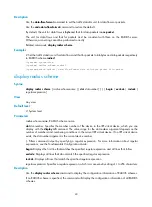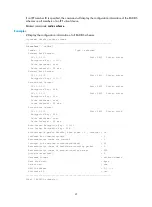
54
Specifying a source address for outgoing RADIUS packets can avoid the situation where the packets sent
back by the RADIUS server cannot reach the device as the result of a physical interface failure.
You can specify up to 16 source IP addresses.
The source IP address specified for RADIUS packets must be of the same IP version as the IP addresses of
the RADIUS servers in the RADIUS schemes that use the specified source IP address. Otherwise, the
source IP address configuration will not take effect.
NOTE:
The setting by the
nas-ip
command in RADIUS scheme view is only for the RADIUS scheme, whereas the
setting by the
radius nas-ip
command in system view is for all RADIUS schemes. The setting in RADIUS
scheme view takes precedence.
Related commands:
nas-ip
.
Examples
# Set the IP address for the device to use as the source address of the RADIUS packets to 129.10.10.1.
<Sysname> system-view
[Sysname] radius nas-ip 129.10.10.1
radius scheme
Syntax
radius scheme
radius-scheme-name
undo radius scheme
radius-scheme-name
View
System view
Default level
3: Manage level
Parameters
radius-scheme-name
: RADIUS scheme name, a case-insensitive string of 1 to 32 characters.
Description
Use the
radius scheme
command to create a RADIUS scheme and enter RADIUS scheme view.
Use the
undo radius scheme
command to delete a RADIUS scheme.
By default, no RADIUS scheme is defined.
The RADIUS protocol is configured scheme by scheme. Every RADIUS scheme must at least specify the IP
addresses and UDP ports of the RADIUS authentication/authorization/accounting servers and the
parameters necessary for a RADIUS client to interact with the servers.
A RADIUS scheme can be referenced by more than one ISP domain at the same time.
You cannot remove the RADIUS scheme being used by online users with the
undo radius scheme
command.
Related commands:
display radius scheme
.






























